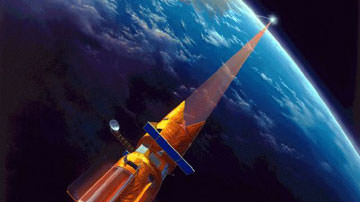[/caption] Mosquitoes are a hardy, resilient sort; these insect have been around for thousands of years and recently,
one mosquito even survived a stint in space.
Mosquitoes aren't just an annoyance, but they also carry deadly diseases. Now, humans may have a new defense against mosquitoes and the diseases they carry, like malaria. Laser technology developed for the Cold War missile defense system called the Strategic Defense Initiative (also known as Star Wars) is now being retooled to for the fight against mosquitoes. The laser system is intelligent enough that humans and butterflies aren't affected by the beams, but it zaps mosquitoes flat. It can even tell the difference between female mosquitoes, the blood-drinkers, and males. "We like to think back then we made some contribution to the ending of the Cold War" with the Star Wars program, said Dr. Jordin Kare. "Now we're just trying to make a dent in a war that's actually gone on a lot longer and claimed a lot more lives."
The original use of the lasers would shield the US against the Soviet nuclear arms. Its rebirth as a bug killer came from Nathan Myhrvold, a former Microsoft Corp. executive who now runs Intellectual Ventures LLC., a company that collects patents and funds inventions. His old boss, Bill Gates, had asked him to explore new ways of combating malaria. At a brainstorming session in 2007, Dr. Lowell Wood, an astrophysicist who helped develop the Star Wars technology, suggested using lasers on mosquitoes.
The scientists envision their technology might one day be used to draw a laser barrier around a house or village that could kill or blind the bugs. Or, laser-equipped drone aircraft could track bugs by radar, sweeping the sky with death-dealing photons.
They now face one big challenge: deciding how strong to make the weapon. The laser has to be weak enough to not harm humans and smart enough to avoid hitting useful bugs. "You could kill billions of mosquitoes a night, and you could do so without harming butterflies," says Myhrvold.
During a recent demonstration, the researchers were able to locate mosquitoes in an old 10-gallon fish tank using a camera with a zoom lens which fed the visual data into a computer which controls the laser and aims the beam at the bugs. When hit, the mosquitoes burst into flame. Each time a beam strikes a bug, the computer makes a gunshot sound to signal a direct hit.
Not only can the laser target a mosquito, it can also tell a male from a female based on wing-beat. That's a crucial distinction, since only females feed on blood and thus transmit disease. "If you really were a purist, you could only kill the females, not the males," Myhrvold sad. But since they're mosquitoes, he says, he'll probably "just slay them all."
Other scientists have worked on ways to eradicate mosquitoes with microwaves, or genetically altering the insects to build a version that is malaria free. Another researcher is looking for a way to make mosquitoes as a force for good, by transforming them into "flying syringes" that deliver vaccines each time they bite.
Source:
Wall Street Journal
 Universe Today
Universe Today
